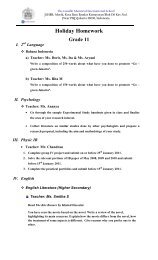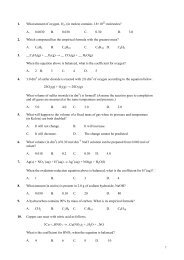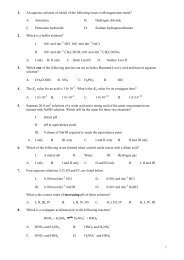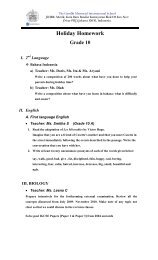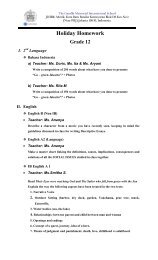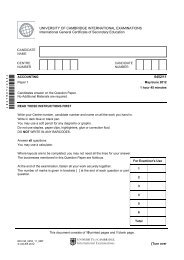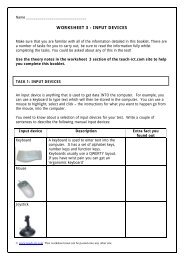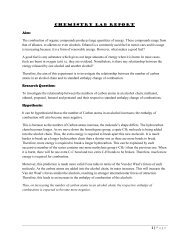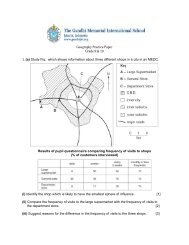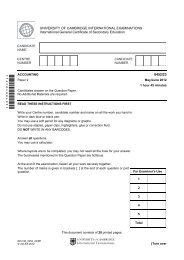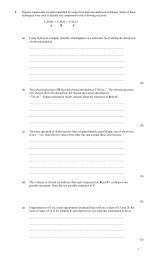nuclear magnetic resonance nmr
nuclear magnetic resonance nmr
nuclear magnetic resonance nmr
- No tags were found...
You also want an ePaper? Increase the reach of your titles
YUMPU automatically turns print PDFs into web optimized ePapers that Google loves.
Nuclear Magnetic Resonance (NMR)NuclearMagneticResonanceIn theNucleusInvolvesMagnetsIn theNucleus
Introduction• NMR is the most powerful tool available fororganic structure determination.• It is used to study a wide variety of nuclei:– 1 H– 13 C– 15 N– 19 F– 31 P
Nuclear Spin• A nucleus with an odd atomic number or anodd mass number has a <strong>nuclear</strong> spin.• The spinning charged nucleus generates a<strong>magnetic</strong> field.3
External Magnetic FieldWhen placed in an external field, spinning protonsact like bar magnets.
The <strong>magnetic</strong> fields ofthe spinning nucleiwill align either withthe external field, oragainst the field.A photon with the rightamount of energy canbe absorbed and causethe spinning proton toflip.Two Energy States
• The nucleus of a hydrogen atom has a very weak<strong>magnetic</strong> spin, it behaves like a weak compass needle.• If a molecule containing hydrogen is placed in a strong<strong>magnetic</strong> field, the <strong>magnetic</strong> hydrogen nucleus can line upwith the field or line up against it!NSNSNucleus spin alignedwith the field – Lowenergy!NNSSNucleus spin alignedagainst the field –High energy!• Which is the high energy orientation?
Excited state = High energyNNSSAddEnergyEnergyReleasedNSNSNSNSAligned = Low EnergyBack to low energy ground state• When the spin falls back into line with the <strong>magnetic</strong> fieldit releases energy. We detect this energy and it providesinformation on:• The environment of the hydrogen in the molecule• How many hydrogen atoms are in that environment.
NMR is a very detailed method of chemical analysis forORGANIC compounds. It can tell us the number ofhydrogen atoms in a molecule and their related positions inthe carbon chain.The nucleus of each hydrogen atom behaves like a tinymagnet, which usually lines up with an applied <strong>magnetic</strong>field. However, if we add energy, the tiny magnet can flipover so that it aligns against the <strong>magnetic</strong> field.When the external energy is removed, the <strong>magnetic</strong>nucleus must, once again, fall back in line with the<strong>magnetic</strong> field and release its extra energy. We detectthis released energy and use it to gather information aboutthe hydrogen which was excited.
The NMR Spectrometer
OBTAINING SPECTRA• a liquid sample is placed in a tube which spins in a <strong>magnetic</strong> field• solids are dissolved in deuterated solvents (CDCl 3 ) or solvents without H‟s(CCl 4 ) [solvents with hydrogen atoms in them will produce peaks in thespectrum]• TMS, tetramethylsilane, (CH 3 ) 4 Si, is added to provide a reference signal.•In practice, the radio wave interacts with the nuclei to cause a rotationof the <strong>nuclear</strong> magnets.•The rotating magnet produces an electrical current in a wire placedaround the sample, and this is what is detected.• In principle, a detector could record the difference in the signal that itreceives compared to the original signal and cause an absorption peakto appear on the chart recorder.
TETRAMETHYLSILANE - TMSPROVIDES THE REFERENCE SIGNALThe molecule contains four methyl groups attachedto a silicon atom in a tetrahedral arrangement. Allthe hydrogen atoms are chemically equivalent.• non-toxic liquid - SAFE TO USE• inert - DOESN‟T REACT WITH COMPOUND BEING ANALYSED• has a low boiling point - CAN BE DISTILLED OFF AND USED AGAIN• all the hydrogen atoms are chemically equivalent - PRODUCES ASINGLE PEAK• given the chemical shift of d = 0• the position of all other signals is measured relative to TMS
chemical environments of Hydrogen• If all the hydrogen atoms in a compound are bonded to a commoncarbon atom, then only one absorption would be observed in the 1H NMRspectrum of the molecule.•For example, the methane molecule, CH 4 , has four chemically equivalenthydrogen atoms and has only one peak in its NMR spectrum.• Hydrogen in different structural arrangements (or chemicalenvironments) give rise to peaks at different positions in the NMRspectrum.For example, the butane molecule, CH 3 −CH 2 −CH 2 −CH 3 , gives rise to twopeaks in the NMR spectrum.One peak is due to <strong>resonance</strong> involving the terminal hydrogens in themethyl groups, −CH 3 , at the end of the molecule; the other is due tothe hydrogens in the methylene groups, −CH 2 −, in the centre of themolecule.This occurs because the nuclei of the hydrogen atoms are shielded byother electrons in the molecule to different extents.The hydrogen nuclei are said to be in different chemical environments.
CHEMICAL SHIFT• each proton type is said to be chemically shifted relative to a standard(usually TMS)• the chemical shift is the difference between the field strength at which itabsorbs and the field strength at which TMS protons absorb• the delta (d) scale is widely used as a means of reporting chemical shifts• the TMS peak is assigned a value of ZERO (d = 0.00)• all peaks of a sample under study are related to it and reported inparts per million
Information from 1 H-<strong>nmr</strong> spectra:1. Number of signals: How many differenttypes of hydrogen's in the molecule.2. Position of signals (chemical shift): Whattypes of hydrogen's.3. Relative areas under signals (integration):How many hydrogen's of each type.4. Splitting pattern: How many neighboringhydrogen's.
LOW RESOLUTION SPECTRA• low resolution <strong>nmr</strong> gives 1 peak for each environmentally different group of protonsLOW RESOLUTION SPECTRUM OF 1-BROMOPROPANE
HIGH RESOLUTION SPECTRA• high resolution gives more complex signals - doublets, triplets, quartets, multiplets• the signal produced indicates the number of protons on adjacent carbon atomsThe broadpeaks are splitinto sharpersignalsHIGH RESOLUTION SPECTRUM OF 1-BROMOPROPANEThe splitting pattern depends on the number of hydrogen atoms on adjacent atoms
1. Number of signals: How many different types ofhydrogens in the molecule.FourTwo
One Two TwoOneOneTwo
2. Position of signals (chemical shift): whattypes of hydrogens.
3. Integration (relative areas under each signal): howmany hydrogens of each type.
MULTIPLICITY (Spin-spin splitting)• low resolution <strong>nmr</strong> gives 1 peak for each environmentally different group of protons• high resolution gives more complex signals - doublets, triplets, quartets, multiplets• the signal produced indicates the number of protons on adjacent carbon atomsNumber of peaks = number of chemically different H‟s on adjacent atoms + 11 neighbouring H 2 peaks “doublet” 1:12 neighbouring H‟s 3 peaks “triplet” 1:2:13 neighbouring H‟s 4 peaks “quartet” 1:3:3:14 neighbouring H‟s 5 peaks “quintet” 1:4:6:4:1Signals for the H in an O-H bond are unaffected by hydrogens on adjacentatoms - get a singlet
Spin–spin splitting is illustrated in the high-resolution1H NMR spectrum of ethanol
4. Splitting pattern: How many neighboring hydrogens
cyclohexanea singlet 12H
2,3-dimethyl-2-buteneH 3 CCH 3 CCH 3CCH 3a singlet 12H
enzenea singlet 6H
ethyl bromidea bCH 3 CH 2 -Bra triplet 3Hb quartet 2H
1-bromopropanea b cCH 3 CH 2 CH 2 -Bra triplet 3Hb hextate 2Hc triplet 3H
Chloropropaneab aCH 3 CHCH 3Cla doublet 6Hb septet 1H
ethanola c bCH 3 CH 2 -OHa triplet 3Hb singlet 1Hc quartet 2H
Propanola b d cCH 3 CH 2 CH 2 -OHa triplet 3Hb complex 2Hc singlet 1Hd triplet 2H
Integration trace• In addition to the NMR spectrum, the NMR spectrometer has drawnwhat is termed „an integrated spectrum trace‟.• The height of each step is a measure of the area under the peak.•It is proportional to the number of hydrogen atoms (protons)resonating at this point in the NMR spectrum.• In this case there are three steps, which are in the ratio of 1 : 2 : 3(from left to right).
MRI• Magnetic <strong>resonance</strong> imaging, noninvasive• “Nuclear” is omitted because of public’s fearthat it would be radioactive.• Only protons in one plane can be in <strong>resonance</strong>at one time.• Computer puts together “slices” to get 3D.• Tumors readily detected.
Magnetic <strong>resonance</strong> imaging (MRI) uses NMR formedical diagnosis.The patient is placed inside a cylinder that contains avery strong <strong>magnetic</strong> field (usually generated by asuperconducting magnet).Radio waves then cause thehydrogen atoms in the watermolecules of the body toresonate.Each type of body tissue emitsa different signal, reflectingthe different hydrogen densityof the tissue.Computer software thentranslates these signals into athree-dimensional picture.
MRI does not ‘see’ bone and can only produce images of softtissues such as blood vessels, cerebrospinal fluid, bone marrow andmuscles.This occurs because the amount of water in bone is very smallcompared to the amount in soft tissue.MRI is used to detect brain tumors, damage caused by multiplesclerosis (MS) or strokes, joint injuries, heart disease (caused bythe narrowing of arteries) and herniated discs.It is regarded as a harmless procedure except to those patientswho have metal implants, such as a pacemaker, joint pins, shrapnelor artificial heart valves.



